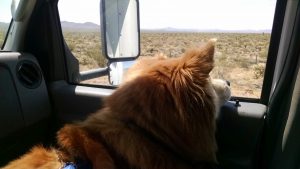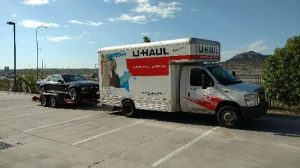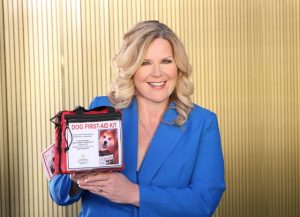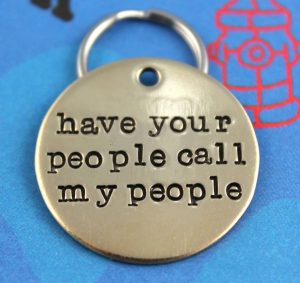 Last summer, we left Southern California for new adventures in the Southeast. Not only did my family plan ahead to provide a smooth transition for our senior dog, Haiku, I needed to recapture the twang of my youth after living in Los Angeles for more than 30 years!
Last summer, we left Southern California for new adventures in the Southeast. Not only did my family plan ahead to provide a smooth transition for our senior dog, Haiku, I needed to recapture the twang of my youth after living in Los Angeles for more than 30 years!
In the months prior to relocating, do your RESEARCH!
State & City Ordinances
- Learn how many pets are allowed per household in your new destination. Los Angeles County permits 4 without a kennel license, 3 in Burbank and my new town…the sky’s the limit!
- Find out if dogs must be registered with the local Animal Services. Many cities require an annual fee and proof of Rabies vaccine.
- Determine any breed or species restrictions.
 Ferrets and Sugar Gliders are illegal in California as they pose a threat to native wildlife. Thirty-six cities in Michigan have dog breed bans or legislation; 62 in Wisconsin, 30 in Arkansas, 90 in Ohio and that’s only scratching the surface. Mostly banned are Pit Bulls, but many other breeds are as well, the list might surprise you. In cities with Breed Specific Legislation, dogs can be confiscated just for riding through, never even stepping paw on a surface!
Ferrets and Sugar Gliders are illegal in California as they pose a threat to native wildlife. Thirty-six cities in Michigan have dog breed bans or legislation; 62 in Wisconsin, 30 in Arkansas, 90 in Ohio and that’s only scratching the surface. Mostly banned are Pit Bulls, but many other breeds are as well, the list might surprise you. In cities with Breed Specific Legislation, dogs can be confiscated just for riding through, never even stepping paw on a surface!
Vaccinations, Health Concerns & Quarantine
Titer tests aren’t accepted everywhere. Something that wasn’t a concern (disease, venomous creatures) may be present in your new surroundings. My Chow-Akita grew up in California where core vaccines included DHPP (Distemper, Hepatitis, Parainfluenza & Parvovirus), however heading to a much wetter climate, I needed to protect him from Leptospirosis. I read up and asked for referrals of veterinarians in the area (from my vet, potential pet sitters and anyone I knew in the Southeast). I quizzed (eh, emailed) prospective veterinarians asking about the need to get the Lepto vaccine before we moved, and it turned into a most helpful exercise in determining which offices provided prompt, complete and informative feedback. It gave me insight and a good, or not so good, opinion of each practice by the responsiveness, friendly manner and advice provided. My research and instincts led me to a veterinarian who is taking excellent care of my dog, and she filled me in on potential wildlife concerns.
 Mode of Transport
Mode of Transport
Road trip was our choice, so harness, seat belt and bed were the main accessories, but of course food and pet first aid kit accessible. We allotted for potty breaks and leg stretches every 4 hours, and needed to identify pet friendly hotels, keeping in mind that “pet friendly” doesn’t mean the same thing to everyone. Some totally lacked grassy  accommodations! We found Holiday Inn Express to be welcoming in Barstow, California while a NO PETS policy existed in other cities. Home2Suites was fabulous in Amarillo, Texas and as a rule La Quinta and Red Roof allow dogs, but call ahead to confirm weight and breed restrictions.
accommodations! We found Holiday Inn Express to be welcoming in Barstow, California while a NO PETS policy existed in other cities. Home2Suites was fabulous in Amarillo, Texas and as a rule La Quinta and Red Roof allow dogs, but call ahead to confirm weight and breed restrictions.
Flying a pet – NOT FOR ME, but if you must…
Plan to travel when weather is best to avoid delays and/or prevent your pet from sitting on the tarmac during heat or cold spells. Small pets may fly underneath a plane seat, but medium to larger dogs must go with the cargo. Hundreds of thousands of dogs travel this way annually, but there are risks including temperature variations, items in cargo sliding around and misdirected pets.
- A baggage cart can save your back and keep you hands-free as you scurry through the airport with a large dog, while riding on wheels will prevent your smaller pet from the swinging caused when his crate is carried by the handle.
- Attach a tag to your pet and to the carrier, along with his Health Certificate, (in a manner that he cannot chew it off). The tag should include the pet’s name, your name and destination address, cell phone and the name and address of an alternate person to contact in case you cannot be located.
Whether you decide to drive or fly, make arrangements well in advance, confirm and re-confirm. Overseas travel (even within the U.S. such as to Hawaii) requires lengthy quarantine periods, and some countries only allow one pet per passport. If your destination is Australia, your pet may be released in 10 days but to Hawaii, the wait can be 4 months; Japan 6 months! There are ways around this, but not without working as a team with your veterinarian months before departure starting blood tests, vaccinations and paperwork. Failing to plan is planning to fail your best friend, so cross every ‘t’ and dot every ‘i.’
BEFORE YOU DEPART
Get a Vet Check
Even though you’ve discussed the move with your veterinarian, started blood work if needed and have learned about vaccinations and boosters, two-weeks prior to leaving, take your best buddy in for a checkup. Obtain a printed copy and/or electronic version of all medical records along with a Health Certificate that states your pet is free from disease and has all necessary shots. Keep these documents handy. I laminated the Health Certificate and kept it up front just in case we were stopped or asked questions at a rest area or hotel.
Practice Longer Car Rides
Although many pets love being in the car, most trips are short…to the dog park, veterinarian, groomer or even the drive-thru. It was a 2,500-mile journey for our boy, so we started doing 90-minute trips to help acclimate him for longer periods on the road.
 First-Aid Kit & Life-giving Water
First-Aid Kit & Life-giving Water
Have what you need to handle a cut paw, bee sting or upset stomach! Ginger snap cookies (the human kind) are my go-to treat 20 minutes before getting in the car, but liquid antacid (check with your vet) is good to bring along. Bottled water from your local store should be packed as even in the nicest hotels, water varies from state-to-state. Your go-to pet food brand might not be available on the road, so bring enough to get you through the first several weeks allowing time to locate or have it shipped. Changing diet in the middle of all the other changes can be asking for diarrhea!

ID Tags
Attach tags to properly fitting collars with your new contact information including cell phone, and be double dog sure the wire ring holding the tags is secure and not poking your pet’s neck. Update microchip information as soon as you have an address, and bring along a clear and current photo of your pet (showing any unique markings) in the event he goes missing. Paws crossed that won’t happen!
Stick to a Schedule
In spite of chaos, stick to a routine, and remember…a tired dog is a good dog. Keeping up with daily walks and exercise, feeding on schedule and taking a quiet time out together will do you both good!
Control Your Own Stress Levels
Life happens and not always as planned. Water & power get shut off a day early, something gets left behind or breaks, you can’t get a cell signal on a remote stretch of highway. I actually had to do a radio interview one morning from the road, so we looked for a place to pull over (to avoid traffic noise) in Nowheresville on the I-40. Whatever happens, do not lose your cool around your pet. Smile, take deep breaths and remember that petting your dog is GRReat therapy for you both!
Catch my Video VLOG on this topic:
Read Part II here:
On the Move with Your Best Friend: Settling into Your New Home Sweet Home
__________________________________________________________
For 20 years Denise Fleck’s Sunny-dog Ink motto has been “Helping people to help their pets,” and she has…teaching more than 30,000 pet lovers animal life-saving skills and millions more on “The Doctors,” CNN, “Kirstie Alley’s Big Life,” Animal Planet and other TV shows. Denise is a frequent conference speaker, developed a line of pet first aid kits and now offers classes online.
Note: The articles on this page are copyrighted. Please do not reprint or use portions for any purpose without written permission from the author. Request permission for usage by sending an email explaining how you’d like to use the materials and what parts specifically. Thank you in advance!








